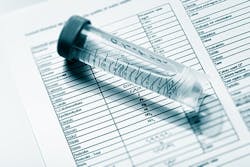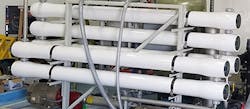Adroitly Address Wastewater Challenges
Wastewater management is one of the most challenging operational issues facing chemical, petrochemical and other process plants today. Three primary factors contribute to this: wastewater compliance standards are growing increasingly strict, water consumption costs are rising, and a water shortage is looming in many areas.
The U.S. Environmental Protection Agency (EPA) assessed a staggering $69 million in pollution penalties in 2018 alone. Meanwhile, the cost of water is getting higher throughout the United States. In addition, more and more processors are treating effective and efficient processing of fluid byproducts as much as a corporate sustainability imperative as an environmental responsibility. This is a pressing issue for all chemical processing operations but smaller facilities may feel improved wastewater management is out of reach because they lack in-house compliance expertise or advanced wastewater-treatment technologies. What’s more, understanding a facility’s wastewater compliance obligations can be difficult because dense regulatory terminology permeate wastewater standards and mandates may depend upon the particular local publicly owned treatment works (POTW).
Chemical processors that take steps to better understand wastewater regulations and deploy advanced technologies to reduce recurring costs associated with wastewater compliance will position themselves for a stronger future. Here are six areas to focus on to take control of wastewater compliance.
1. Criteria Behind Regulations
Wastewater discharge regulations include a fair amount of complexity. Lack of a high-level understanding of their framework and enforcement can pose a real barrier to effective and efficient compliance management.
Since 1972, the United States has pursued an increasingly stringent water control program. From the EPA’s perspective, two kinds of wastewater discharges need to be regulated under the Clean Water Act (CWA): direct discharges into “waters of the United States” and indirect discharges that pass through a POTW for treatment prior to being released into the water supply.
Indirect discharges are regulated through a national pretreatment program that is a cooperative effort of federal, state and local environmental regulatory agencies. The objective of the program is to protect POTWs’ infrastructure and reduce the amount of industrially generated pollutants discharged into the municipal sewer system and the environment.
The EPA has established three primary kinds of pretreatment standards:
• general and specific prohibited discharge standards for all industrial users;
• categorical pretreatment standards for particular industrial categories, including inorganic chemicals, ink formulating, oil and gas extraction, organic chemicals, plastics and synthetic fibers, paint formulating, pesticide chemicals, petroleum refining, pharmaceutical manufacturing, rubber manufacturing, and soap and detergent manufacturing; and
• local limits that are site-specific to ensure the POTW will not process waste that passes through to the water supply or interferes with operations.
Standards outside of the CWA also factor into wastewater compliance. Under the Resource Conservation and Recovery Act (RCRA), the EPA regulates the transport, treatment, storage and disposal of solid waste (including oils and sludges). While not a direct component of discharge regulations, U.S. Occupational Safety and Health Administration (OSHA) standards also impact a chemical processor’s approach to wastewater management. Toxic and other hazardous gases can arise when certain inorganic pollutants in wastewater mix in the discharge collection system. OSHA sets exposure limits on toxic and air contaminants to protect worker health. POTWs will reduce this risk by controlling the maximum level of pollutants discharged.
Tip: When it comes to understanding the scope of wastewater requirements for a plant — and optimizing solutions to manage wastewater treatment — operators must appreciate that air discharge limits also play a role. For example, a wastewater treatment system requires proper ventilation. If a wet scrubber removes toxic substances from gases, the toxic substances will collect in the wastewater generated by the scrubber, creating an additional wastewater stream to manage.
2. The Purposes Of Permitting
At a minimum, the EPA requires all significant industrial users (SIUs) to have permits. The EPA defines SIUs as:
• industrial users (IUs) that fall under categorical pretreatment standards due to their industry;
• IUs that discharge an average of 25,000 gal/d or more of process wastewater (excluding sanitary, noncontact cooling and boiler blowdown wastewater) to the POTW;
• IUs that contribute a process waste stream that makes up 5% or more of the average dry-weather hydraulic or organic capacity of the POTW;
• IUs that the control authority identifies as having a reasonable potential to adversely affect the POTW’s operation; and
• IUs that have violated any pretreatment standard or requirement.
The permitting process usually is one of the clearest illustrations that the onus of proactive wastewater compliance falls on the process plant. Not only can local wastewater authorities define SIUs in their jurisdiction more stringently than the federal EPA but also EPA counsels local wastewater authorities to communicate pretreatment standards during the permitting process. In “The Industrial User Permitting Guidance Manual,” https://bit.ly/3k8fpg1, the EPA states that, in its experience, “the permit is the most effective means of ensuring that industrial users are aware of all applicable pretreatment requirements.”
Most permit applications require plants to disclose a broad range of details about their wastewater management, such as a description of operations, wastewater generating and discharge activities, and the pollutants potentially in the wastewater and on-site. From the chemical processor’s perspective, it would seem that the operator must supply all the details of its wastewater management practices prior to learning which discharge regulations will apply. This approach compromises the operator’s ability to initiate pollution abatement practices that may streamline permit approvals and reduce surcharges levied by the POTW to cover costs for treating wastewater with excessive pollution levels.
Tip: For plants that add an in-house wastewater treatment system, the permit application will need to clearly state where the system will be located within the facility and the location of the sample port so regulators can perform testing. Some suppliers of wastewater treatment technology will work with plants and wastewater regulators to submit and obtain the necessary permits on behalf of the facility.
Figure 1. Selecting the most appropriate treatment system requires a detailed and accurate analysis of the wastewater.
3. Recurring Compliance Costs
Wastewater compliance can incur many costs such as treatment expenses, labor investments¬¬ and fines that can erode a chemical processor’s bottom line.
Wastewater compliance lapses, for example, can lead to serious financial liability. A facility negligently or knowingly discharging to a POTW in violation of federal or local pretreatment standards can face significant penalties:
• negligence violations — initial penalty: 1 year and/or $2,500–$25,000/d, subsequent convictions: 2 years and/or $50,000/d; and
• knowing violations — initial penalty: 3 years and/or $5,000–$50,000/d, subsequent convictions: 6 years and/or $100,000/d.
If a discharge introduces a pollutant or hazardous substance into a POTW and the person knew or reasonably should have known such pollutant could result in injury or damage the system, or the discharge causes the plant to violate its own permit, the penalties are the same as those for a discharge to a POTW in violation of a local pre-treatment program.
Chemical processors have two choices if they are to avoid such compliance fines: treat wastewater to meet local POTW standards prior to discharging it to the sewer or pay to have wastewater hauled away and treated, which easily can total several thousand dollars per week. The costs to transport (either by bulk drums or tankers) and treat wastewater are increasing and likely will continue trending upward. According to data from the U.S. Bureau of Labor Statistics, costs for waste collection and remediation services rose 12% from June 2014 to June 2019.
Tip: Facilities that have an in-house wastewater treatment system and a discharge permit are not exempt from monitoring and testing. These plants still must perform regular visual tests and send samples out for an official analysis (usually twice a year). Additionally, failure to pay fees, charges or surcharges typically are viewed as compliance lapses and also are subject to legal action.
4. Water Use Costs
While wastewater compliance is a necessary aspect of chemical manufacturing, reducing water consumption expenses is a related component of cost-effective wastewater management.
According to estimates in 2017 research from the American Council for an Energy-Efficient Economy, among all U.S. manufacturing sectors, chemical making accounted for the third greatest volume of water withdrawal, behind only pulp and paper and primary metals. More important, though, the chemicals subsector ranked highest in consumptive use, followed by primary metals and petroleum refining.
With water costs rising and water demand expected to exceed the current supply by 2030, taking steps to reduce water consumption through wastewater recycling and re-use could dramatically impact chemical processing facilities for the better.
Tip: Recycling or repurposing washdown water can cut water consumption substantially. For example, a chemical blender of industrial metalworking fluids uses as much as 20% of its incoming water to clean out the facility’s mixing vats. Treating this water enables its reuse, markedly reducing incoming water usage.
5. Outside Expertise
Achieving wastewater compliance in a cost-effective manner requires a balance of technology and compliance expertise. An ability to work with local control authorities to become familiar with applicable regulations and adopt measures to meet the regulations underpins this.
Unfortunately, chemical companies — whether new or long-established — can find pursuing pre-emptive compliance measures extremely challenging when their primary information liaison is also the enforcing party. An experienced, trusted supplier of industrial wastewater treatment technology will be familiar with local and federal pre-treatment standards and, in some cases, can act as an “information agent.” For example, when a plant operator poses questions to wastewater regulatory officials, it may risk inviting followup requests from the regulator. As a neutral third party, a wastewater equipment supplier may be able to answer the questions itself or consult with regulators without disclosing specific details.
Furthermore, wastewater treatment systems for chemical plants are not one-size-fits-all. Determining the most cost-efficient and effective technology for the specific application requires a thorough understanding of the wastewater’s makeup (Figure 1). For example, correctly specifying and optimizing a reverse osmosis system demands the following data: pH, total dissolved solids, chemical oxygen demand, biochemical oxygen demand, operating temperature, chloride, ammonia, oil and grease, total suspended solids, sulfates, calcium, magnesium, and emulsified oil and grease.
Tip: Do not exclusively rely on historical wastewater data. Carefully evaluate the current wastewater in the context of the plant’s current operating parameters, which are subject to change as production goals fluctuate. An experienced and trusted supplier of industrial wastewater technology can evaluate a facility’s wastewater stream by running tests and obtaining a laboratory analysis of samples before and after various treatment options. From those results, the supplier can recommend the proper equipment and treatment methods to recycle or repurpose the permeate.
Figure 2. This technology can remove up to 99.5% of dissolved salts and impurities, and often serves as the final step in a treatment system.
6. Zero-Liquid-Discharge Technologies
The EPA’s Effluent Guidelines, set technology-based numerical limitations for specific pollutants on an industry-by-industry basis, including several chemical processing applications. The guidelines don’t require the use of a specific technology to achieve reduction.
Several available zero-liquid-discharge technologies can be installed on-site to cut water pollution and prepare water for repurposing within the production facility. In many instances, a plant may need to deploy multiple modular technologies to optimize wastewater treatment and recycling. Three of the most common processes for chemical plant wastewater treatment are ultrafiltration, vacuum evaporation and reverse osmosis.
• Ultrafiltration uses low pressure to push wastewater through a semipermeable membrane. The technology filters out organics, emulsified oils and suspended solids, reducing oily water volumes by as much as 98% without chemicals. Ultrafiltration systems can cut the cost of washwater and detergents by as much as 75% and decrease haul-away costs by 90%. Such systems can help manufacturing facilities meet a goal not hauling away any wastewater and provide them the ability to meet RCRA requirements and state and local discharge regulations.
• Vacuum evaporation is one of the most effective methods for mitigating the risks and costs associated with chemical manufacturing wastewater. This process removes salts, heavy metals and a variety of hazardous components. It restores 90–95% of the original distillate (water), cuts the cost of washwater and detergents up to 75%, and reduces water costs up to 99%. Vacuum evaporation also has a low carbon footprint.
• Reverse osmosis is a low-maintenance method that removes dissolved solids by using high pressure to push wastewater through a semipermeable membrane. The technology removes up to 99.5% of dissolved salts and impurities. Often this technology serves as the final process after ultrafiltration or chemical treatment of wastewater.
Tip: Partner with a wastewater treatment system supplier that offers all types of technology and that will work in lockstep with plant operators throughout the entire equipment acquisition — from sampling and permitting to testing and installation. Also, be sure to pursue testing and feasibility studies before equipment selection. Equipment suppliers that collect wastewater samples from the plant, run those samples through their proprietary wastewater treatment systems and then verify the results of the processing through a certified laboratory not only have proof of projected water quality improvements but also will have collected data required for a new discharge permit application.
Buoy Your Bottom Line
Wastewater regulations almost will certainly grow increasingly stringent. Chemical processors that partner with wastewater treatment experts to establish improved compliance practices will benefit from lower discharge fees, labor costs and haul-away expenses. In addition, by recycling wastewater to the production line for use, a plant will lower fresh water expenses. Chemical manufacturers that leverage this potential will make wastewater compliance less of a drain on their operation.
TIM HANNA is the vice president of business development for PRAB, Kalamazoo, Mich. Email him at [email protected]




